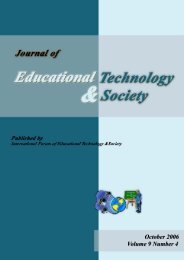Student Engagement: What do we know and what should we do?
Student Engagement: What do we know and what should we do?
Student Engagement: What do we know and what should we do?
Create successful ePaper yourself
Turn your PDF publications into a flip-book with our unique Google optimized e-Paper software.
interesting qualitative criteria <strong>and</strong> differing definitions of engagement in learning, which,<br />
consequently, has had some impact on how <strong>we</strong> ‘assess’ learning. Ans<strong>we</strong>rs to this<br />
refocused question have also surfaced a gap bet<strong>we</strong>en <strong>what</strong> teachers consider engagement<br />
in learning <strong>and</strong> <strong>what</strong> students consider engagement in learning. A move to linking student<br />
engagement to learning, as opposed to linking it to achievement, lifts the question of<br />
measurement to the forefront because it asks us to measure the process <strong>and</strong> not simply the<br />
content of learning.<br />
<strong>What</strong> is the promise of <strong>Student</strong> <strong>Engagement</strong>? Clearly, student engagement is an<br />
important <strong>and</strong> rich research topic. Educators must continue to seek to underst<strong>and</strong> <strong>and</strong><br />
apply specific, <strong>we</strong>ll considered, if not agreed upon strategies that support student<br />
engagement in learning both in <strong>and</strong> beyond the classroom. The consequences of not<br />
engaging students in learning are reportedly dire (Prensky, 2001; Tapscott, 1998; Gilbert,<br />
2007; Willms, 2003, p. 56; Claxton, 2007). “Some educationists consider engaging<br />
disengaged pupils to be one of the biggest challenges facing educators, as bet<strong>we</strong>en 25%<br />
(Willms, 2003) <strong>and</strong> over 66% (Cothran & Ennis, 2000) of students are considered to be<br />
disengaged” (as cited in Harris, 2008, p. 57).<br />
<strong>Student</strong>s who are bored, restless, disruptive, <strong>and</strong> disengaged in the short term have clearly<br />
<strong>do</strong>cumented negative impacts on students, teachers, schools, <strong>and</strong> communities. Ho<strong>we</strong>ver,<br />
the greater issue is that students could be graduating incapable of or unprepared for a<br />
productive <strong>and</strong> healthy life within the “Knowledge Society” in which they will live <strong>and</strong><br />
lead (Gilbert, 2007). The negative consequences of this deficit of engagement in learning<br />
would ripple across industry <strong>and</strong> society for generations. If <strong>we</strong> fail to make changes to<br />
our pedagogy, curriculum, <strong>and</strong> assessment strategies, <strong>we</strong> fail our students <strong>and</strong> jeopardize<br />
our futures (Willms, 2003; Robinson, 2009; Tapscott, 1998; Prensky, 2005, Gilbert,<br />
2007).<br />
We <strong>know</strong> our students have changed over the last t<strong>we</strong>nty years; perhaps as a result of a<br />
technology rich upbringing, they appear to have “different” needs, goals, <strong>and</strong> learning<br />
preferences than students had in the past. We need to better underst<strong>and</strong> these youth <strong>and</strong><br />
determine how to best engage them in learning; yet, there is a notable lack of “student<br />
voice” or student perspectives in the literature on student engagement. That said, some<br />
critics, such as those mentioned by Carlson (2005), Young (2006), Carnivale (2006),<br />
Bennett, <strong>and</strong> Maton, & Kervin (2007) <strong>do</strong> not believe today’s students differ or that they<br />
require special educational concessions: in fact, they believe <strong>we</strong> are dumbing <strong>do</strong>wn an<br />
entire generation through such coddling: As “Professor Baron” is quoted in Carlson<br />
(2005):<br />
It is very common to hear people say, ‘Here's the Millennial or the digital<br />
generation, <strong>and</strong> <strong>we</strong> have to figure out how they learn. Poppycock. We get to<br />
mold how they learn.’ Administrators push professors to use technology in the<br />
classroom because they believe that is <strong>what</strong> today students want is, says Ms.<br />
Baron. And faculty members feel pressured to shorten lectures, increase<br />
group-discussion time, <strong>and</strong> ignore the “multitasking” student who is e-mailing<br />
his friends in the back of the room -- all to attract <strong>and</strong> satisfy a generation that<br />
<strong>do</strong>esn't have the discipline of its predecessors. ‘We think that the students will<br />
<strong>Student</strong> <strong>Engagement</strong>: <strong>What</strong> <strong>do</strong> <strong>we</strong> <strong>know</strong> <strong>and</strong> <strong>what</strong> <strong>should</strong> <strong>we</strong> <strong>do</strong>? 4












